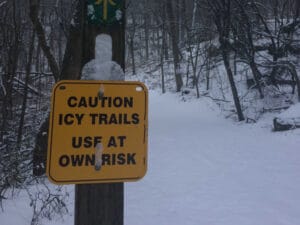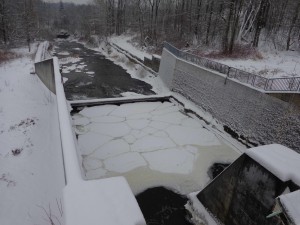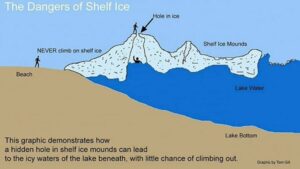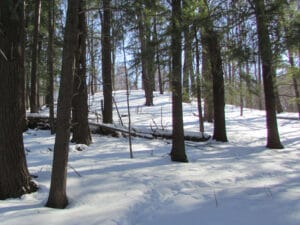Winter is a great time to get out and explore! Enjoying the outdoors in a different season can be a whole new experience! Getting out in winter however, presents its own unique hazards that anyone enjoying the outdoors should be aware of before heading out.
Know the Dangers of Hazard Areas
HCA areas include Niagara Escarpment, Lake Ontario shoreline, wetlands, ponds, lakes, creeks, streams and dams. Ice safety is more than just being aware of thin ice. The best way to enjoy a safe visit is to keep all members of the family and pets off all ice, except official skating areas, and away from cold water.
Click through each to learn more and how to stay safe.
 While some of our trails are maintained for winter recreation, many HCA trails travel through passive areas such as valley lands and escarpment brows. Icy conditions can exist at any time during the winter, especially in valley areas. Extreme caution should be used where the ground is uneven or near a cliff edge as icy conditions may cause slips and falls. Avoid approaching the escarpment edge where ice or snow may compromise solid footing or hide possible dangers.
While some of our trails are maintained for winter recreation, many HCA trails travel through passive areas such as valley lands and escarpment brows. Icy conditions can exist at any time during the winter, especially in valley areas. Extreme caution should be used where the ground is uneven or near a cliff edge as icy conditions may cause slips and falls. Avoid approaching the escarpment edge where ice or snow may compromise solid footing or hide possible dangers. Dams pose a number of hazards, especially during winter. Dams typically have water flowing through them which prevents the formation of a thick ice sheet nearby. Ice near a dam should never be walked on. HCA offers the opportunity to walk across some of our dams as part of our trail network. Note that the walkways across dams are often very slippery and handrails should be used when crossing. Running and jogging should be avoided. Extreme care is required around dams with many hazards such as steep banks and cold water present. Never walk on any part of a dam that is not clearly marked for passage.
Dams pose a number of hazards, especially during winter. Dams typically have water flowing through them which prevents the formation of a thick ice sheet nearby. Ice near a dam should never be walked on. HCA offers the opportunity to walk across some of our dams as part of our trail network. Note that the walkways across dams are often very slippery and handrails should be used when crossing. Running and jogging should be avoided. Extreme care is required around dams with many hazards such as steep banks and cold water present. Never walk on any part of a dam that is not clearly marked for passage.Lake and marina ice forms sometime after mid-November and usually stays until the end of March. This ice is NOT consistent. In some places it may be 50cm thick, yet adjacent ice may only be a few centimetres thick. If it is covered by recent snow, the ice may appear the same to the unsuspecting person. Ice may come and go on a daily basis. Because of wave action on the lake, even very thick ice can be broken up by storms and is highly unpredictable.
 During most winters huge mounds of ice form along parts of the Lake Ontario shoreline. They may look compelling to climb on but they are EXTREMELY dangerous. They can break apart at any time, they are very slippery and if one was to fall into the water on the lakeside of these mounds, getting out of the water is virtually impossible. STAY AWAY. Enjoy their beauty from a distance.
During most winters huge mounds of ice form along parts of the Lake Ontario shoreline. They may look compelling to climb on but they are EXTREMELY dangerous. They can break apart at any time, they are very slippery and if one was to fall into the water on the lakeside of these mounds, getting out of the water is virtually impossible. STAY AWAY. Enjoy their beauty from a distance.
Dangers of Cold Water
Make no mistake: If a person enters cold water, it is a life-threatening situation. Click through to learn more.
Cold water kills. Make no mistake about it; there may be only minutes between life and death when water approaches 0 degrees Celsius. Not only must we consider the amount of time in the water that a person might be exposed to, but also the time it takes to get a person to a warm place after rescue.
Please note the location of our Hypothermia Safety Kits before venturing on to the ice. These are available at the major HCA areas. Please check for their exact location when you visit. Automatic External Defibrillators (AED’s) are also located in the major conservation areas.
Ice Factors
Many factors affect ice thickness including: type of water, location, the time of year and other environmental factors such as:
- Water depth and size of body of water
- Currents and other moving water
- Chemicals including salt
- Fluctuations in water levels
- Logs, rocks and docks absorbing heat from the sun
- Changing air temperature
Ice Safety
Just because ice is present does not mean it is safe. Click through to learn more and how to stay safe.
- Clear blue ice is strongest.
- White opaque or snow ice is half as strong as blue ice. Opaque ice is formed by wet snow freezing on the ice.
- Grey ice is unsafe. The greyness indicates the presence of water.
- 15 cm (6 inches) for walking or skating in pairs
- 20 cm (8 inches) for skating parties or games
Avoid going out on ice at night.
HCA Ice Status
HCA areas are posted as safe or unsafe on site, but it is still a good idea to check before heading out.
Dogs
More than ever, dog owners should ensure their pets are on leash. Conservation Authority regulations state that dogs must be leashed at all times. If there was ever a reason to keep your dog on a leash this is it. Dog owners are often put at severe risk because they try to rescue their dog that’s wandered off and fallen through the ice or into deep water at the edge of the ice.
Top Takeaways
- Stay away from all water bodies – conditions can vary greatly and be unpredictable.
- Do not go out on ice unless posted as safe to do so.
- Keep well back from escarpment edges.
- Falling into cold water is a life threatening situation. Note the location of onsite hypothermia kits if available.
- Watch children closely and keep them away from water and escarpment edges.
- Keep pets leashed at all times for their safety and yours.
Don’t let all this information scare you off! Winter is still a beautiful time to be outdoors, but as with anything, it is important to be aware of hazards and use best practices. Make winter safety your priority, and enjoy some safe, fun, healthy activities in the great outdoors this winter season!
Some information contained within this post is copyrighted © 1999-2009 Canadian Red Cross.







